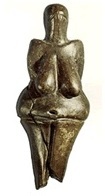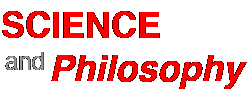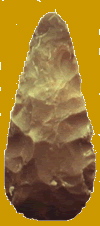Mithen, Steven The Prehistory of the Mind, Thames and Hudson, London 1996 [450 word excerpt] — the intelligence of prehistoric humans
The most characteristic artifact produced by Early Humans was the handaxe. Even a brief look at Early Human handaxes indicates a number of significant differences from those artifacts produced within the previous Oldowan tradition. [Oldowan time - from about 1.8 million to 600,000 years ago]. They often display high degrees of symmetry, sometimes simultaneously in three dimensions, and indicate that the knapper was imposing form on to the artifact, rather than just creating sharp edges as with an Oldowan chopper.
To achieve such symmetry and form, longer knapping sequences were required. These can be appreciated from the refitting of knapping debris from sites such as Boxgrove in southern England, where handaxes were made 500,000 years ago. To make a handaxe, great care must be paid to the initial selection of the stone nodule with regard to its shape, quality and likely fracture dynamics.
Manufacture involves roughing out the handaxe using a stone hammer followed by final shaping often with a ‘soft’ hammer made of bone or wood. Flakes are removed from alternate sides of the artifact in turn, which is why the technique is often described as bifacial knapping, and the artifacts as bifaces. A soft hammer can detach flakes with shallow scars to create an artifact that is relatively thin. Prior to the removal of each thinning flake, the edge of the artifact may be ground for a few moments or have small flakes removed, in preparation for a strike.
The difficulty in achieving a symmetrical handaxe of a specified form has been stressed by Jacques Pelegrin, who has many years’ experience at replicating handaxes. He has explained how the goal of the knapper is not simply to obtain a sharp cutting edge but to extricate an artifact of a specific form independent from the starting shape of that nodule. Planning ahead is essential if symmetry is to be achieved, and maintained as the piece is developed. The knapper needs to assess both what is desirable and what is possible, and achieve such ends by blows of a specific force and direction at specific points on the artifact.
Each nodule worked by a knapper will have its own unique characteristics and challenges. Consequently, to produce standardized forms, the knapper needs to exploit and adapt his or her toolmaking knowledge, rather than just follow a fixed set of rules in a rote fashion. This final point is particularly important since many collections of handaxes from single sites are of very similar shape and size. If we assume that the original nodules are unlikely to have been exactly the same shape, then we have a fine example of the imposition of a specified form.
 .................
................. ................
................
Art gallery 25,000 to15,000 B.C.


